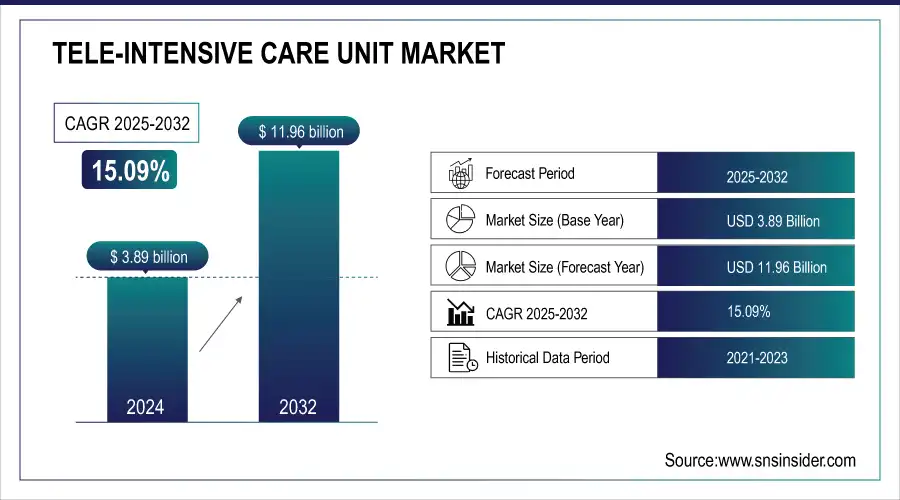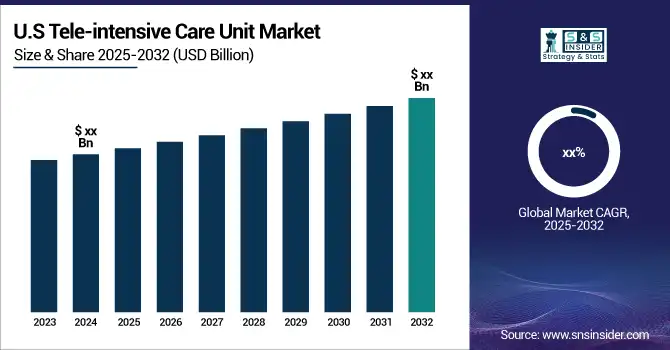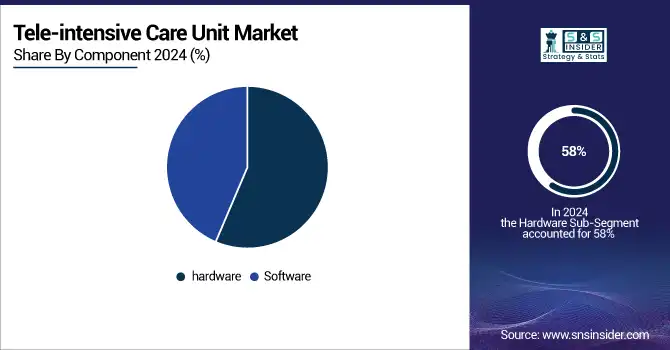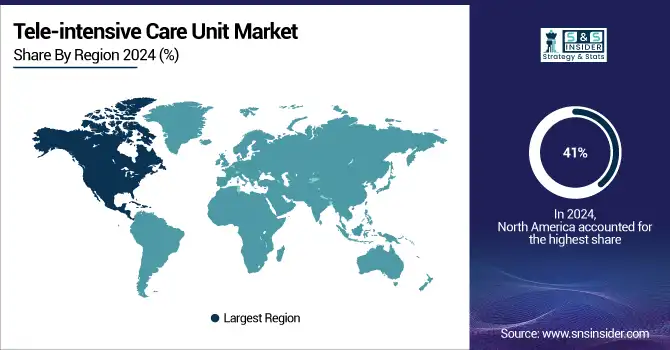Tele-intensive Care Unit Market Size Analysis
The Tele-intensive Care Unit Market was valued at USD 3.89 billion in 2024 and is expected to reach USD 11.96 billion by 2032, growing at a CAGR of 15.09% from 2025-2032.
The Tele-Intensive Care Units (Tele-ICU) market is witnessing rapid growth, driven by technological advancements and the rising demand for remote healthcare solutions. Tele-ICUs enable specialists to monitor critically ill patients in real time, improving outcomes, optimizing hospital resources, and expanding access to care, particularly in underserved regions. Integration of AI, cloud computing, predictive monitoring, and video conferencing is enhancing decision-making and efficiency, reducing costs and minimizing patient transfers. Major players like Philips and Banner Health are leading innovations, showcasing the potential of tele-ICUs to transform critical care delivery.
The increasing elderly population worldwide is another key factor contributing to the expansion of tele-ICUs. China had a per capita ICU bed rate of 3.6, closely followed by India with 2.3 ICU beds per 100,000 individuals by 2024. It highlights the urgent necessity for countries to reassess their ICU bed capacity.

Get More Information on Tele-intensive Care Unit Market - Request Sample Report
Tele-intensive Care Unit Market Trends
-
Rising prevalence of chronic and critical illnesses is driving demand for tele-ICU solutions.
-
Integration of AI, analytics, and remote monitoring technologies is enhancing critical care delivery.
-
Shortage of intensivists and skilled healthcare professionals is boosting tele-ICU adoption.
-
Cloud-based platforms and IoT-enabled devices are enabling real-time patient data access.
-
Growing acceptance of virtual healthcare and telemedicine is supporting market growth.
-
Hospitals are adopting tele-ICUs to reduce mortality rates, improve outcomes, and optimize resource utilization.
-
Collaborations between healthcare providers, tech companies, and government programs are accelerating deployment.

Tele-intensive Care Unit Market Growth Drivers
-
Rising demand for remote healthcare services is a key factor boosting the tele-ICU market due to the increasing popularity of telemedicine and remote healthcare solutions.
The tele-ICU market is experiencing growth due to the rising usage of telemedicine and remote healthcare solutions. Challenges such as geographic barriers, limited specialized medical professionals, and hospital overcrowding are being addressed by tele-ICUs as a practical solution for healthcare systems. Tele-ICUs allow intensivists to remotely monitor and take care of patients, offering instant consultations and interventions, ultimately enhancing patient results. This is particularly advantageous for hospitals situated in underserved or rural areas that may not have immediate access to specialized care. Having the capacity to provide top-notch critical care from a distance helps hospitals navigate limitations in resources and enhance patients' ability to receive essential services.
-
Progress in Monitoring and Communication Technology
Progress in AI software, cloud computing, and remote monitoring tools are transforming the efficiency and availability of tele-ICUs. These advancements facilitate ongoing, live tracking of patients, enabling healthcare providers to quickly detect any deterioration in patient status and intervene promptly. Cloud-based platforms offer immediate access to patient information and facilitate collaborative decision-making, making them highly advantageous. AI-driven analysis improves decision-making by forecasting possible issues, enabling intensivists to act promptly and make decisions based on data. Furthermore, these technologies enhance the cost-effectiveness of tele-ICUs by decreasing the requirement for specialists on the premises, yet maintaining top-notch patient care. By combining AI and cloud-based technology, tele-ICUs can handle more patients, streamline hospital resources, and shorten hospital stays, resulting in better healthcare outcomes and delivery.
Tele-intensive Care Unit Market Restraints
-
The Tele-Intensive Care Unit (Tele-ICU) market is the expensive initial setup costs required to implement tele-ICU systems.
These systems need high-tech infrastructure, like video display panels, communication devices, physiological monitoring tools, and specialized software for managing real-time data and monitoring patients. The starting capital could pose a challenge, especially for smaller hospitals or healthcare facilities with restricted finances. Furthermore, incorporating these systems into current healthcare structures may need substantial resources and time for staff training and compatibility with other hospital systems. Financial constraints may hinder the widespread implementation of tele-ICU solutions, especially in areas or facilities where budget limitations are an issue.
Tele-intensive Care Unit Market Segment Analysis
By Component: Hardware dominated while Software is expected to grow fastest
The hardware segment had the highest market share in the tele-intensive care unit market in 2024, accounting for 58% of revenue. Market growth is being driven by the increasing adoption of digital health and telehealth, fueled by technological advances. Additionally, remote patient monitoring depends greatly on telemedicine tools like blood pressure monitors, wearable EKG/ECG devices, biosensors, blood glucose monitors, digital medical scopes, and accessories, as well as wearable activity trackers such as smartwatches and wristbands. Innovation in hardware is anticipated to spur market growth in the years ahead.
The software segment is expected to experience the highest growth rate during the forecasted period. With the growing use of telehealth in healthcare facilities, new software platforms have been developed to help manage critical care more effectively. These platforms enable intensive care specialists to quickly retrieve patient information, vital signs, and treatment histories through real-time data sharing. Additionally, they integrate sophisticated analytics and machine learning algorithms, improving decision-making skills and predicting outcomes for severely ill patients. For example, Philips eICU, provided by Koninklijke Philips N.V., uses predictive algorithms to recognize and prioritize patients for timely interventions.

By Type: Open consultant led while Intensivist is projected to grow fastest
In 2024, the open consultant segment held the largest market share at 26%. This segment showcases the potential and practicality of tele-ICU consultation and scheduled rounds. It allows bedside teams to interact with international experts, talk about patient cases, and get treatment suggestions. For example, Inova provides enVision teleICU to help hospital staff care for critically ill patients, leading to the expansion of the market.
It is expected that the intensivist segment will experience the most rapid growth during the forecast timeframe. The intensivist model utilizes a dedicated intensive-care specialist to manage the tele-ICU system on a full-time basis. In this model, the patient's issues are addressed straightforwardly. This section offers effective clinical judgments to handle any issues. There is an anticipated increase in intensivists' availability over the forecast period, which will drive growth in the segment.
Tele-intensive Care Unit Market Regional Analysis
North America Tele-intensive Care Unit Market Insights
In 2024, North America accounted for the highest revenue share of 41% in the tele-intensive care unit market. Advanced IT infrastructure, fast internet connectivity, and strong communication networks drive the growth of the region. In addition, the increase in new product introductions and the participation of leading established companies in North America have contributed to the growth of the market. Whitfield Regional Hospital and the University of Alabama at Birmingham collaborated to establish the first UAB Tele-Intensive Care Unit expanded hospital in June 2024. Through this collaboration, Whitfield now has the benefit of ongoing Tele-ICU assistance, consisting of a group of skilled tele-intensivists and ICU nurses based at UAB.

Need Any Customization Research On Tele-intensive Care Unit Market - Inquiry Now
Asia Pacific Tele-intensive Care Unit Market Insights
The Asia Pacific region is forecasted to see the fastest growth in the tele-intensive care unit market. The growing popularity of telehealth solutions in the area is fueling market expansion. In August 2024, Tele-ICU was launched by Aster Digital Health, a division of Aster DM, after a four-month trial period has already provided valuable assistance to over 250 patients across various rural locations in India. This technology monitors patient data from a distance, providing expert guidance and ongoing observation, resulting in improved outcomes and reduced death rates for severely ill patients, particularly in medium and high-risk situations.
In July 2023, Medanta Hospital Group, a leading healthcare provider, revealed the launch of tele-ICU services in India through the Medanta e-ICU project.
Europe Tele-intensive Care Unit Market Insights
In Europe, the Tele-Intensive Care Unit (Tele-ICU) market is expanding as healthcare systems adopt advanced digital health solutions to improve critical care delivery. Rising ICU admissions, shortage of intensivists, and growing adoption of AI-driven monitoring tools are fueling demand. Governments and hospitals are investing in tele-ICU infrastructure to enhance efficiency, reduce costs, and improve patient outcomes. Increasing elderly populations further accelerate the region’s reliance on remote intensive care solutions.
Middle East & Africa and Latin America Tele-intensive Care Unit Market Insights
In the Middle East & Africa, the Tele-ICU market is gaining traction due to limited specialist availability and increasing investments in digital healthcare infrastructure. Hospitals are adopting remote monitoring to expand access in underserved regions. In Latin America, growing healthcare digitization, rising ICU demand, and government support for telemedicine are driving adoption. Both regions benefit from tele-ICUs’ ability to enhance patient care, optimize resources, and reduce the burden on overcrowded intensive care facilities.
Tele-intensive Care Unit Market Competitive Landscape:
GE Healthcare
GE Healthcare plays a vital role in the Tele-Intensive Care Unit (Tele-ICU) market with advanced patient monitoring and critical care solutions such as Centricity Critical Care. Its technologies enable real-time data integration, remote monitoring, and improved clinical decision-making, helping hospitals optimize ICU resources. By leveraging digital platforms and AI-driven insights, GE Healthcare supports enhanced patient outcomes, reduced healthcare costs, and wider access to specialized critical care across diverse healthcare environments.
-
In 2023, GE Healthcare and Medanta launched India’s Medanta e-ICU service, delivering 24/7 remote monitoring and specialist support, enabling real-time ICU care and improved outcomes without patient transfers.
Philips Healthcare
Philips Healthcare is a leading player in the Tele-Intensive Care Unit (Tele-ICU) market, offering solutions like the eICU Program and IntelliVue Patient Monitors. Its platforms enable remote patient monitoring, predictive analytics, and real-time clinical decision support. By integrating AI, cloud computing, and advanced data analysis, Philips enhances care efficiency, reduces ICU strain, and improves patient outcomes. The company’s innovations are widely adopted by hospitals worldwide, reinforcing its leadership in virtual critical care.
-
In 2023, Philips deployed the region’s first AI-enabled Tele-ICU in Saudi Arabia, augmenting bedside teams through remote monitoring, reducing mortality and ICU stays as part of healthcare transformation under Vision 2030.
-
In 2024, Unveiled its Silent ICU concept at HIMSS24: SDC-enabled interoperable devices let clinicians remotely manage alarms and patient data via a vendor-neutral ecosystem for a calmer ICU environment.
-
In 2024, Philips introduced an advanced clinical command eICU center in Saudi Arabia’s Madinah Health Cluster, providing remote ICU surveillance from 350 km away to support critical care across hospitals.
Cloudphysician Healthcare
Cloudphysician Healthcare is an emerging player in the Tele-Intensive Care Unit (Tele-ICU) market, specializing in cloud-based remote critical care platforms. Its solutions connect intensivists to ICUs in real time, enabling advanced monitoring, timely interventions, and better resource utilization. By leveraging AI, data analytics, and telemedicine, Cloudphysician enhances patient outcomes, especially in regions with limited specialist availability. The company’s focus on accessibility and scalability positions it as a key contributor to the growing tele-ICU landscape.
-
In 2024, Cloudphysician secured US $10.5 million in Series A funding to scale its RADAR smart-ICU platform (AI-enabled, documentation-assisted) and expand internationally into the U.S., Middle East, and Southeast Asia.
-
In 2024, pediatric critical-care initiative, Cloudphysician partnered with global health programs to assess and optimize tele-ICU deployment in NICUs across India, marking its third consecutive year of innovation in remote pediatric care.
Tele-Intensive Care Unit Market Key Players
-
Inova Health System (Inova Tele-ICU Services, Inova Critical Care Transport)
-
InTouch Health (InTouch Telemedicine Solutions, InTouch ICU Virtual Care)
-
Philips Healthcare (IntelliVue Patient Monitors, eICU Program)
-
Advanced ICU Care (Virtual ICU Services, Remote ICU Monitoring Systems)
-
GE Healthcare (Centricity Critical Care, Patient Monitoring Solutions)
-
Hicuity Health (Hicuity Health Tele-ICU Platform, Virtual Critical Care Services)
-
Equum Medical (Virtual Critical Care Solutions, Remote ICU Services)
-
MUSC Health (ICU Telemedicine Solutions, Critical Care Telemedicine Programs)
-
iMDsoft (MetaVision ICU Software, MetaVision Anesthesia
-
Cloudphysician Healthcare (Remote Critical Care Platform, Cloud-based ICU Services)
-
CLEW (CLEW-ICU AI System, CLEW ICU Analytics)
-
Cerner Corporation (Remote Patient Monitoring Solutions, Cerner Telehealth Platform)
-
Honeywell Life Care Solutions (Life Care Solutions Telehealth System, Vital Signs Monitoring Systems)
-
Biotelemetry (Telehealth Monitoring Solutions, Real-Time Patient Data Analytics)
-
Dara Biosciences (Tele-ICU Critical Care Solutions, Remote ICU Data Management)
-
Intensive Care Consortium (ICC) (Virtual ICU Solutions, ICU Management Platforms)
-
Vici Health (Tele-ICU Remote Monitoring, Virtual ICU Telemedicine Solutions)
-
Ascom (Ascom Healthcare Solutions for ICU, Ascom Myco Smart Phones for Healthcare)
-
Zebra Medical Vision (AI-powered Medical Imaging for Tele-ICU, Automated Critical Care Insights)
-
Medtronic (CareAware Virtual ICU Solutions, Medtronic Patient Monitoring Systems)
Tele-intensive Care Unit Market Key Suppliers
These suppliers provide essential tools and technologies that support personalized medicine biomarkers, ranging from diagnostic assays to sequencing systems and imaging solutions.
-
Dräger Medical
-
GE Healthcare
-
Philips Healthcare
-
Medtronic
-
Mindray
-
Siemens Healthineers
-
TeleTracking Technologies
-
Zebra Medical Vision
-
CureMetrix
-
Vyaire Medical
| Report Attributes | Details |
|---|---|
| Market Size in 2024 | US$ 3.89 Billion |
| Market Size by 2032 | US$ 11.96 Billion |
| CAGR | CAGR of 15.09% From 2024 to 2032 |
| Base Year | 2024 |
| Forecast Period | 2025-2032 |
| Historical Data | 2021-2022 |
| Report Scope & Coverage | Market Size, Segments Analysis, Competitive Landscape, Regional Analysis, DROC & SWOT Analysis, Forecast Outlook |
| Key Segments | •By Component (Hardware, Software) •By Type (Open with Consultant, Intensivist, Co-Managed, Open, Others) |
| Regional Analysis/Coverage | North America (US, Canada, Mexico), Europe (Eastern Europe [Poland, Romania, Hungary, Turkey, Rest of Eastern Europe] Western Europe [Germany, France, UK, Italy, Spain, Netherlands, Switzerland, Austria, Rest of Western Europe]), Asia Pacific (China, India, Japan, South Korea, Vietnam, Singapore, Australia, Rest of Asia Pacific), Middle East & Africa (Middle East [UAE, Egypt, Saudi Arabia, Qatar, Rest of Middle East], Africa [Nigeria, South Africa, Rest of Africa], Latin America (Brazil, Argentina, Colombia, Rest of Latin America) |
| Company Profiles | Inova Health System, InTouch Health, Philips Healthcare, Advanced ICU Care, GE Healthcare, Hicuity Health, Equum Medical, MUSC Health, iMDsoft, Cloudphysician Healthcare, CLEW, Cerner Corporation, Honeywell Life Care Solutions, Biotelemetry, Dara Biosciences, Intensive Care Consortium (ICC), Vici Health, Ascom, Zebra Medical Vision, Medtronic, and other players. |

